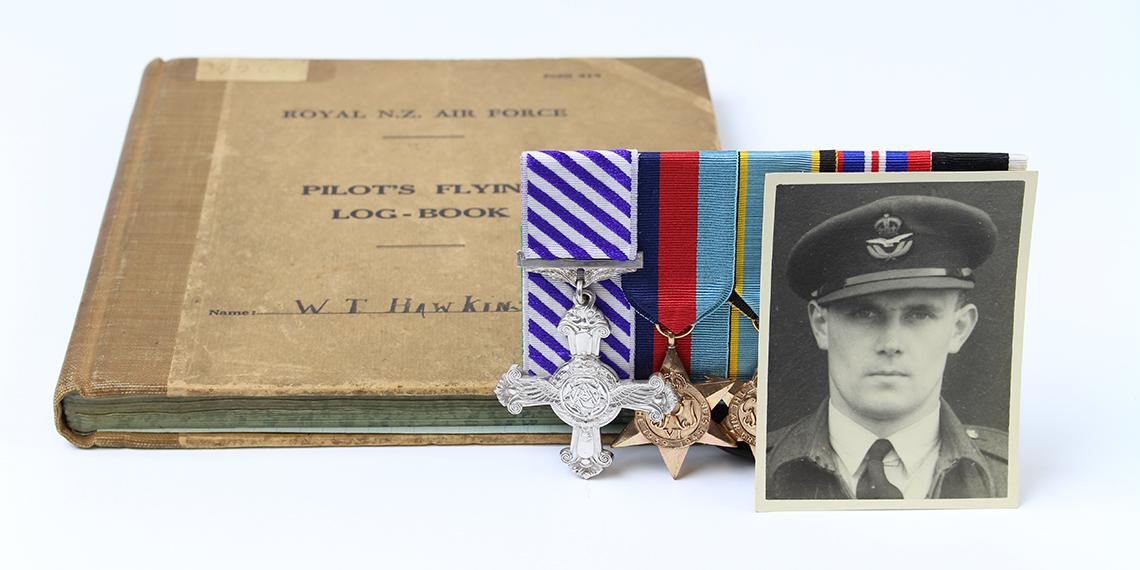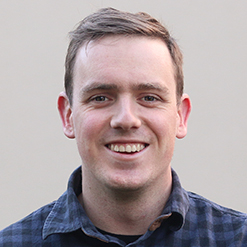You are here
Heroes of War and Faith

In celebration of Anzac Day, Hugh Collins uncovers the lives of three Salvationists who served on the frontlines of World War II.
If you’re fortunate enough to get behind several doors into the intriguing world of The Salvation Army’s Heritage and Archives Centre, you will find a treasure trove of artefacts pertaining to the Army’s rich history in Aotearoa.
A plethora of these objects feature evidence of Salvationist involvement with the major world wars, most notably a box of possessions once owned by Kiwi Salvationist fighter pilot Bill Hawkins. The collection has a range of Hawkins’ personal items including World War II medals, a personal diary, photo album and pilot’s logbook.
‘The essence’ of Bill Hawkins
William Tinsley Hawkins was born in Wellington on 19 August 1918. He travelled extensively throughout New Zealand with his officer parents, while learning to play the cornet from a young age. A cabinet maker by trade, by 1939 he had transferred back to Wellington City Corps where he became an integral part of its brass band.
In February 1941, a year and a half after the start of World War II, Hawkins enlisted in the Royal New Zealand Air Force, and entered the war effort as a pilot on the flight decks of Spitfires and Mustangs. He went on to fly 60 missions for the RAF (Royal Air Force), logging 814 flying hours.
A report from the Gisborne Herald, dated 23 November 1942, claims he was one of the first pilots to fly over the German frontier. ‘They flew Mustangs to within a few miles of Bremen, shooting up an enemy camp, a factory, a gasometer, and barges on the Dortmund-Ems canal. The whole flight covered a journey of over 700 miles,’ the report stated.
His final mission on 27 September 1943 has been documented by the RAF, claiming it concerned ‘shipping reconnaissance’ off the Dutch coast. Taking to the skies in a Mustang, Hawkins and a second fighter attacked five German E-Boats. However, they were later intercepted by two enemy fighters, 40 miles west of the Dutch town of Den Helder. Hawkins tragically perished in the sea and was never found. He was just 25.
The day before his death his squadron received word he had been awarded the Distinguished Flying Cross (DFC) award—the highest award given to an RAF pilot. The award’s citation read that Hawkins always displayed great enthusiasm for operational flying, and that on his final mission he ‘destroyed an enemy aircraft and much vital war material’.
Territorial Archivist Sharon Burton says it’s unusual for the Salvation Army to have such a unique collection, but Archives were blessed to have the family donate them.
‘Things like this tend to get spread around a family and they go missing. So we’re very fortunate that it’s so comprehensive,’ Sharon says. ‘It’s the essence of Bill Hawkins in the box.’
In his diary he regularly describes his feelings, as well as discussing aspects of his social life. The photo album depicts his journey from Wellington to Canada and on to the UK, with some stunning photography.
His diary captures details of his life during the war. Here are a few excerpts from January 1942:
Wednesday, January 14th: We went to see some Churchill tanks today and I had a drive in one. The officer’s mess in this particular place was in the servants quarters of a marvellous abbey and the place was riddled with underground tunnels
Thursday, January 15th: I did some aerobatics in a Tiger Moth
Saturday, January 19th: We were supposed to leave for an exercise down south but the weather did not permit flying
‘For me as a salvationist coming from Wellington City Corps, it’s special in that he was one of ours,’ Archives Research and Content Manager Selwyn Bracegirdle says.
If you’re familiar with Tom Hardy’s Spitfire pilot character in the film Dunkirk, you’ll have a rough idea of the kind of experiences probably faced by Bill Hawkins!
One of the greatest soldiers—Commissioner Dean Goffin
Born in Wellington in 1916 into a musical Salvation Army family, Sir Dean Goffin took to music at a young age and in 1936 became bandmaster of the Wellington South Band. He enlisted for the New Zealand Army shortly after the outbreak of World War II and was soon appointed bandmaster of the 4th Brigade band. In 1941, he was sent to the Greek Island of Crete where he served as Lieutenant.
Symphony of Thanksgiving follows the life and times of Sir Goffin and has a chapter dedicated to his involvement in World War II. Excerpts from letters home detail his experiences, most notably as they fought German and Italian forces on Crete. He talked of marching 22 miles in the dark. It was ‘the roughest going imaginable’.
‘I felt a supreme power upholding me and as the night breeze cooled my body and played around my throbbing temples, I felt, as it were, a bastion of prayer surrounding me sustaining and upholding me.
‘Death became utterly trivial and unimportant, sacrifice and suffering a pleasure, hunger and thirst were old friends by now—we ridiculed them and quietened them with a joke, brotherliness and generosity became more important than food and drink, an encouraging grin more effective then rhetoric, and Christianity crystallized itself in my mind as being utterly and sincerely natural.’
The book notes how surviving members of his band agreed on his exemplary leadership, courage under fire, decisiveness and care and concern for his men.
Sir Howard Kippenberger, a famous New Zealand military commander, said Sir Dean’s performance as a platoon commander demonstrated him as one of New Zealand’s greatest soldiers. Dean went on to become Territorial Commander for New Zealand and Fiji in 1980.
He composed a number of well-known Salvation Army band numbers, some of which are kept on vinyl today in the Archives of Booth College. In 1983 he was knighted in the Queen’s Birthday Honours List.
A great Salvationist—Colonel Norman Bicknell
Born in Melbourne in 1904, Colonel Norman Bicknell was described at his funeral in 1996 as ‘one of New Zealand’s greatest 20th century Salvationists’.
His leadership first began at the age of 17, in 1921, as deputy bandmaster and solo cornetist with the Newton Salvation Army in Auckland.
Norman was first summoned to war on 31 December 1939, as a military chaplain, or padre. Salvation Army corps leaders had received a call from the acting territorial commander that the padre appointed to the 1st Echelon could not go and was wondering if Bicknell would take his place. He had two hours to decide. Sure enough, he boarded a ship bound for North Africa and, by 13 February, was serving as chaplain to the 4th Field Ambulance of the 1st Echelon in Egypt.
He later followed New Zealand troops to Greece—a country then under German occupation. At his funeral, Major Cyril Bradwell spoke of his exemplary conduct, as New Zealand troops were forced to retreat and evacuated under intense air attack.
In the North African Battle of Sidi Oman he was attached to a Mobile Surgical Unit that was overrun by German forces and held captive for eight days. ‘[Bicknell’s] unassuming spiritual leadership, adaptability, integrity and understanding of men were allied to the highest personal standards of conduct and courage,’ a news article said.
By Hugh Collins (c) 'War Cry' magazine, 20 April 2019, p14-15 - You can read 'War Cry' at your nearest Salvation Army church or centre, or subscribe through Salvationist Resources.
